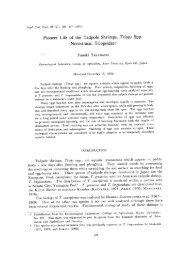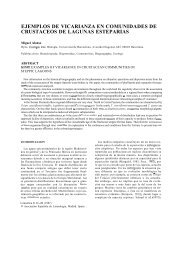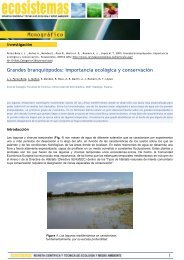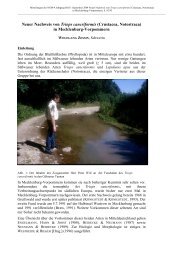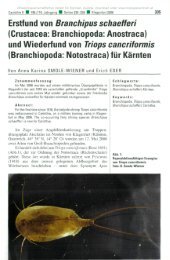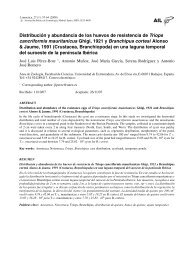Reproductive isolation and genetic differentiation in North American ...
Reproductive isolation and genetic differentiation in North American ...
Reproductive isolation and genetic differentiation in North American ...
Create successful ePaper yourself
Turn your PDF publications into a flip-book with our unique Google optimized e-Paper software.
134<br />
Figure 5. Frequency histograms of telson sp<strong>in</strong>e counts <strong>in</strong> Triops<br />
longicaudatus (solid bars) <strong>and</strong> T. newberryi (stippled bars).<br />
Figure 4. Frequency distributions of meristic character values <strong>in</strong><br />
Triops longicaudatus (solid bars) <strong>and</strong> T. newberryi (stippled bars).<br />
A. Legless body r<strong>in</strong>gs. B. Total body r<strong>in</strong>gs.<br />
or fluctuat<strong>in</strong>g selection. The latter two have been proposed<br />
as alternate hypotheses to expla<strong>in</strong> large <strong>genetic</strong><br />
differences between nearby pools <strong>in</strong> some freshwater<br />
crustaceans (e.g., Hebert, 1974; Lynch, 1987; Hairston<br />
& Dillon, 1989; Boileau et al., 1992).<br />
Morphological <strong>differentiation</strong> between species <strong>and</strong><br />
among populations<br />
The <strong>genetic</strong> <strong>differentiation</strong> between the two <strong>North</strong><br />
<strong>American</strong> Triops species (Figure 2) is accompanied<br />
by significant, but subtle, morphological <strong>differentiation</strong><br />
<strong>in</strong> the numbers of legless body r<strong>in</strong>gs <strong>and</strong> the total<br />
body r<strong>in</strong>g counts (Figure 4). The two species clearly<br />
differ <strong>in</strong> these two characters, but the nature of the difference<br />
is complex. For both variables, the distribution<br />
of character states for T. newberryi lies between the<br />
two modes of a bimodal distribution represent<strong>in</strong>g the<br />
character states for T. longicaudatus. The two species<br />
also differ <strong>in</strong> the number of sp<strong>in</strong>es <strong>in</strong> the central row<br />
on the dorsum of the telson (Figure 5). Rank-order<br />
comparsions of these two distributions <strong>in</strong>dicate a highly<br />
significant difference, despite extensive overlap <strong>in</strong><br />
values. Analysis of carapace ratio did not provide any<br />
clear pattern of <strong>differentiation</strong> between the two species.<br />
These four morphological characters were also<br />
used to exam<strong>in</strong>e patterns of morphological differentation<br />
between populations with<strong>in</strong> each species. Mean<br />
values <strong>and</strong> st<strong>and</strong>ard deviations for the four characters<br />
are given <strong>in</strong> Tables 3 <strong>and</strong> 4 for populations of T.<br />
newberryi <strong>and</strong> T. longicaudatus, respectively. Data are<br />
summarized only for populations <strong>in</strong> which at least five<br />
<strong>in</strong>dividuals were measured. These data were exam<strong>in</strong>ed<br />
by ANOVA to <strong>in</strong>vestigate <strong>in</strong>traspecific heterogeneity.<br />
Parametric analyses were followed by pairwise multiple<br />
comparisons us<strong>in</strong>g the Student-Newman-Keuls<br />
test, <strong>and</strong> non-parametric (Kruskal-Wallis rank order)<br />
tests were followed by multiple comparisons us<strong>in</strong>g<br />
Dunn’s test. S<strong>in</strong>ce population variances were heterogeneous<br />
<strong>in</strong> all comparisons (except for telson sp<strong>in</strong>ation<br />
<strong>in</strong>T. longicaudatus males), <strong>and</strong> the general pattern of<br />
differences was comparable between parametric <strong>and</strong><br />
non-parametric analyses, only the latter are presented<br />
here.<br />
In T. newberryi, sample sizes were too small to<br />
allow statistical comparisons among males from different<br />
populations. Comparisons among females, however,<br />
generally <strong>in</strong>dicated that sexual populations do<br />
not differ substantially from each other, nor do sexual<br />
populations consistently differ from unisexual popu-



